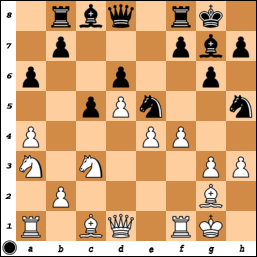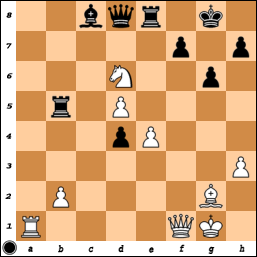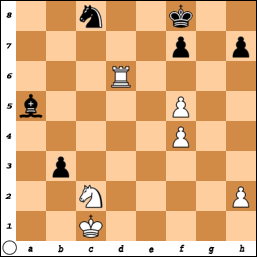Of course it's impossible to provide real in-depth analysis here as there's simply not enough time for that and the post would always grow seriously large. I'll leave it two games per post.
Round 1: Uwira, O. (2230) - Euler, G. (2348)
1. d4 Nf6 2. c4 e6 3. g3 c5 4. d5 exd5 5. cxd5 d6 6. Nc3 g6 7. Bg2 Bg7 8. Nf3 O-O 9. O-O Nbd7 10. e4 Re8 11. Nd2 a6 12. a4 Rb8 13. Nc4 Ne5 14. Na3 Nh5 15. h3 Rf8 16. f4?! (Diagram)
 This is an adventureous idea that is nevertheless not sufficient to obtain the advantage. Opinions as to the quality of the move differed considerably between the players. While I thought the move was worth a try, my opponent considered it to be a severe blunder. The other extreme was maintained by IM Reschke who thought that White is better. The main move is 16.Kh2. 16...Nxg3 17. fxe5 Nxf1 18. Qxf1 Bxe5 Now White has to find something against f7-f5, which will yield Black a very strong attack. Driving the black rook off the f-file is strong but also quite natural. 19. Bh6! Re8 Maybe Black should have played 19...Bd4+ 20.Kh1 Re8 to prevent the tactical trick White has prepared. 20. Nc4 Bd4+ 21. Be3!
This is an adventureous idea that is nevertheless not sufficient to obtain the advantage. Opinions as to the quality of the move differed considerably between the players. While I thought the move was worth a try, my opponent considered it to be a severe blunder. The other extreme was maintained by IM Reschke who thought that White is better. The main move is 16.Kh2. 16...Nxg3 17. fxe5 Nxf1 18. Qxf1 Bxe5 Now White has to find something against f7-f5, which will yield Black a very strong attack. Driving the black rook off the f-file is strong but also quite natural. 19. Bh6! Re8 Maybe Black should have played 19...Bd4+ 20.Kh1 Re8 to prevent the tactical trick White has prepared. 20. Nc4 Bd4+ 21. Be3!  At first sight this looks as if White has blundered a piece after 21...b5 but this in fact allows White to simplify by tactical means, thus reaching an endgame that is about equal. However, Black doesn't really have a choice because White's minor pieces are becoming very active while Black's Rb8 is still asleep. 21...b5 22. axb5 axb5 23. Bxd4 cxd4 24. Nxb5 Rxb5 25. Nxd6 (Diagram) Here Black must play 25...Qxd6 26.Qxb5 Bd7 27.Qd3 Qb6! 28.Rd1 Qxb2 29.Qxd4 with an equal endgame. Black, however, is struck by a bout of chess blindness. 25...Rxb2?? 26. Qxf7+ 1-0
At first sight this looks as if White has blundered a piece after 21...b5 but this in fact allows White to simplify by tactical means, thus reaching an endgame that is about equal. However, Black doesn't really have a choice because White's minor pieces are becoming very active while Black's Rb8 is still asleep. 21...b5 22. axb5 axb5 23. Bxd4 cxd4 24. Nxb5 Rxb5 25. Nxd6 (Diagram) Here Black must play 25...Qxd6 26.Qxb5 Bd7 27.Qd3 Qb6! 28.Rd1 Qxb2 29.Qxd4 with an equal endgame. Black, however, is struck by a bout of chess blindness. 25...Rxb2?? 26. Qxf7+ 1-0Round 2: Grabarczyk, B. (2433) - Uwira, O. (2230)
The finish of this encounter has already been talked about. We'll focus on the events that led up to said finish.
1. e4 c5 2. Nf3 Nc6 3. d4 cxd4 4. Nxd4 Nf6 5. Nc3 e5 6. Ndb5 d6 7. Bg5 a6 8. Na3 b5 9. Bxf6 gxf6 10. Nd5 f5 11. Bd3 Be6 12. Qh5 I had never faced that line over the board and also didn't expect to see it at all because almost everybody plays 12.0-0 here. This is probably not because 12.Qh5 is weaker but because 12.0-0 was hyped by various authors as the antidote against the Sveshnikov. 12...Rg8 13. g3 Rg4 14. f4 exf4 15. Nxf4 Rxf4 16. gxf4 Up until now it's all in the books. My next move is a rarely played alternative to the main move 16...Qa5+ and likely isn't worse.16...Qf6 17. exf5 Bd5 18. O-O-O (Diagram)
 An important crossroads. Black could get his exchange back with 18...Bxh1 19.Qe2+ Kd7 20. Rxh1 when he should not be worse after 20...Bh6!. The text move sacrifices the exchange for good but takes aim at the White king. Again I'm playing creatively but too aggressively, which is a pattern that up until now characterises my play during the whole tournament. 18...Bg7?! 19. Rhe1+ Kf8 20. c3 b4? That should have lost the game immediately due to a miscalculation after 21.Bc4! when the White king will hide behind a Black pawn at b2 and the exchange will begin to tell. Better would have been 20...Nb4 when Black is only slightly worse according to the silicon monster. 21. Nc2? Bxa2 22. Qg5 bxc3 23. Qxf6 Bxf6 24. bxc3 Bxc3 Dark clowds loom above the White king but with his next move White manages to exploit the temporary disorder in Black's army, thus defending against the imminent danger. 25. Re3! Rb8?
An important crossroads. Black could get his exchange back with 18...Bxh1 19.Qe2+ Kd7 20. Rxh1 when he should not be worse after 20...Bh6!. The text move sacrifices the exchange for good but takes aim at the White king. Again I'm playing creatively but too aggressively, which is a pattern that up until now characterises my play during the whole tournament. 18...Bg7?! 19. Rhe1+ Kf8 20. c3 b4? That should have lost the game immediately due to a miscalculation after 21.Bc4! when the White king will hide behind a Black pawn at b2 and the exchange will begin to tell. Better would have been 20...Nb4 when Black is only slightly worse according to the silicon monster. 21. Nc2? Bxa2 22. Qg5 bxc3 23. Qxf6 Bxf6 24. bxc3 Bxc3 Dark clowds loom above the White king but with his next move White manages to exploit the temporary disorder in Black's army, thus defending against the imminent danger. 25. Re3! Rb8? I calculated this very far, but not far enough. Better would have been 25...Na5! with the idea of 26.Bc4? Bd2+!. 26. Bb5 Ba5 27. Ra3 axb5 28. Rxa2 b4 29. Rxd6 b3 30. Ra4 Rc8 31. Rc4 Ne7 32. Rxc8+ Nxc8 (Diagram) I've seen this far but missed the strength of 33.Rc6! here which would have won for White. The little detail that got lost in the inevitable fuzzyness of a long calculation is that Black can't play 33...bxc2 because then the zwischenzug 34.f6!! decides the game (instead 34.Rxc8+? Kg7 looks drawish). 33. Ra6? Bc7! 34. Nb4 Bxf4+ 35. Kb2 Kg7 36. h3 Nd6 37. f6+ Kg6 38. Kxb3 Ne4 39. Kc4 Ng5 40. Nd5 Be5 41. h4 Ne6 42. Ra3 Nf4 43. Rg3+ Kf5 44. Rg5+ Ke6 45. Nxf4+ Bxf4 46. Rh5 Kxf6 47. Rxh7 Kg6 48. Rh8 Be5 49. Rg8+ Kh6 50. Rf8 Kh5 51. Kd5 Bf6 52. Ke4 Kxh4 53. Kf5 Bd4 54. Rd8 Bf2 55. Rd3 Bg3 56. Rd7 Kh3 57. Ke4 f5+?? You already know that one. Nevertheless a tremendous tactical battle. 58. Kf3 1-0
I calculated this very far, but not far enough. Better would have been 25...Na5! with the idea of 26.Bc4? Bd2+!. 26. Bb5 Ba5 27. Ra3 axb5 28. Rxa2 b4 29. Rxd6 b3 30. Ra4 Rc8 31. Rc4 Ne7 32. Rxc8+ Nxc8 (Diagram) I've seen this far but missed the strength of 33.Rc6! here which would have won for White. The little detail that got lost in the inevitable fuzzyness of a long calculation is that Black can't play 33...bxc2 because then the zwischenzug 34.f6!! decides the game (instead 34.Rxc8+? Kg7 looks drawish). 33. Ra6? Bc7! 34. Nb4 Bxf4+ 35. Kb2 Kg7 36. h3 Nd6 37. f6+ Kg6 38. Kxb3 Ne4 39. Kc4 Ng5 40. Nd5 Be5 41. h4 Ne6 42. Ra3 Nf4 43. Rg3+ Kf5 44. Rg5+ Ke6 45. Nxf4+ Bxf4 46. Rh5 Kxf6 47. Rxh7 Kg6 48. Rh8 Be5 49. Rg8+ Kh6 50. Rf8 Kh5 51. Kd5 Bf6 52. Ke4 Kxh4 53. Kf5 Bd4 54. Rd8 Bf2 55. Rd3 Bg3 56. Rd7 Kh3 57. Ke4 f5+?? You already know that one. Nevertheless a tremendous tactical battle. 58. Kf3 1-0


Hier gibt es hoffentlich eine Fortsetzung. Für einen Hobbyspieler waren die nächsten zwei Runden nicht ganz verständlich - es gab bestimmt versteckte Feinheiten, oder?
ReplyDeleteWas war das heute? Geht es bei dem Turnier um den Hessen- oder (Oster)hasenmeister :-)
ReplyDeleteWenn das so weitergeht, können die Punkte am 18.04. per Post nach Heusenstamm geschickt werden. Dort wird auf jeden Fall schon die Meisterfeier geplant. Bis heute hatte ich das als Überheblichkeit eingestuft...
Mal sehen, welche Ostereier morgen gelegt werden.
Wer den Schaden hat braucht für den Spott nicht zu sorgen.
ReplyDeleteUnd ich hatte bis jetzt doch noch gehofft, dass es nur ein schlechter Aprilscherz war...
ReplyDeleteDasselbe hatte ich bisher eigentlich auch gehofft. Allerdings bist bist Du einfach ein ganz schön arroganter Zeitgenosse, mein Freund, wie Du auch in Sebastians Blog immmer unter Beweis stellst, der anscheinend nur auf Provokation aus ist.
ReplyDeleteAber Dir ist vielleicht bewusst, dass Leute mit 2200 bis 2300 keine GM's sind, ja?
Ich werde meine Konsequenz jetzt daraus ziehen, jegliches von Dir geschriebenes zu ignorieren, wenn Du nicht wenigstens noch den Mumm entwickelst, Dich zu erkennen zu geben.
Ich bin auch so schon frustriert genug und muss mich von Deinen Bildzeitungsparolen nicht noch mehr die Laune verderben lasssen.
Du hast recht. An einigen Stellen habe ich deutlich überzogen. Einige Ereignisse am Schachbrett waren für den Laien nicht verständlich, aber der Ton macht die Musik.
ReplyDelete